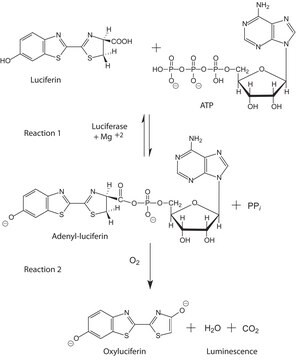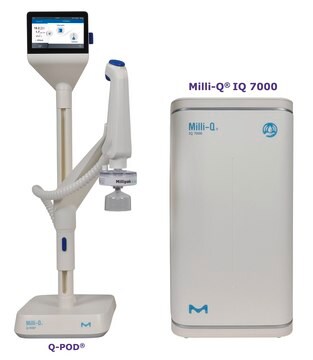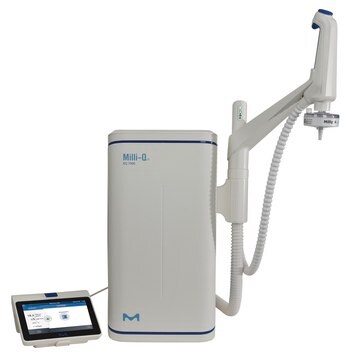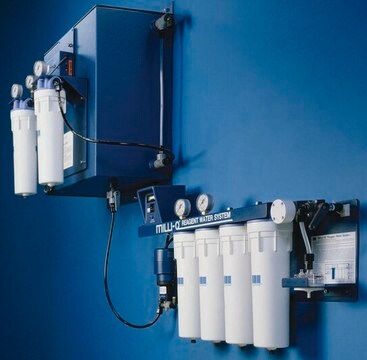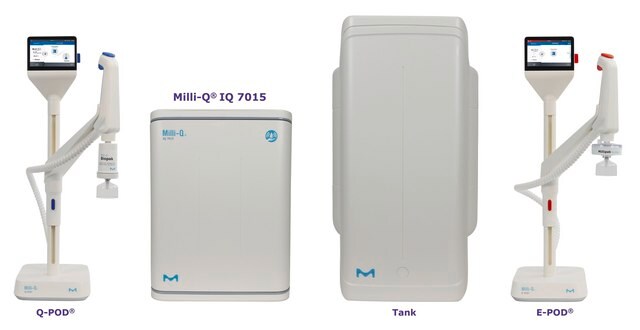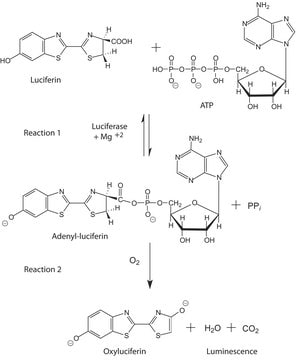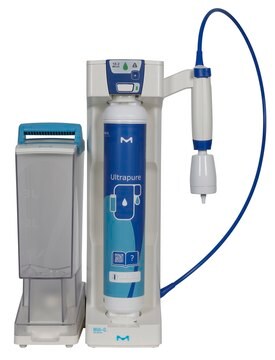11699695001
Roche
ATP Bioluminescence Assay Kit CLS II
sufficient for 800 assays (tubes), kit of 1 (2 components), suitable for detection
Synonym(s):
bioluminescence assay
Sign Into View Organizational & Contract Pricing
All Photos(1)
About This Item
UNSPSC Code:
12352204
Recommended Products
Assay
>98%
Quality Level
usage
sufficient for 800 assays (tubes)
packaging
kit of 1 (2 components)
manufacturer/tradename
Roche
parameter
15-25 °C optimum reaction temp.
application(s)
detection
shipped in
dry ice
storage temp.
−20°C
General description
ATP bioluminescence assay is a sophisticated micro count method. It works based on the capability of fireflies to generate its glowing cold light. Rise in proliferation for all cytohexdrin concentrations can be determined by ATP bioluminescence assay.
Specificity
The ATP Bioluminescence Assay Kit CLS II is specially developed for applications in which constant light signals are required for kinetic studies of enzymes and metabolic studies, or if coupled enzymatic assays are applied. If ATP determinations are performed manually, the CLS Kit provides high reproducibility due to the constant signal generation.
The sensitivity of the kit is reduced by a factor of 10, compared to the ATP Bioluminescence Assay Kit HS II, which is recommended for determinations that are in the high-sensitivity range. The ATP Bioluminescence Assay Kit HS II also contains an efficient cell lysis reagent, and can be used for the detection of ATP in microorganisms or animal cells.
The sensitivity of the kit is reduced by a factor of 10, compared to the ATP Bioluminescence Assay Kit HS II, which is recommended for determinations that are in the high-sensitivity range. The ATP Bioluminescence Assay Kit HS II also contains an efficient cell lysis reagent, and can be used for the detection of ATP in microorganisms or animal cells.
Application
ATP Bioluminescence Assay Kit CLS II has been used in the determination of the ATP synthetic activity of the H+-ATP synthase, ATP bioluminescent assay and intracellular measurement of ATP levels.
The ATP Bioluminescence Assay Kit CLS II is optimized for easy use in tube luminometers and microplate-format luminometers. The kit exhibits a constant light signal that is sustained for several minutes. The kit is well suited for kinetic studies and ATP determinations in coupled enzymatic reactions.
For more highly sensitive ATP determinations, use the ATP Bioluminescence Assay Kit HS II.
For more highly sensitive ATP determinations, use the ATP Bioluminescence Assay Kit HS II.
Packaging
1 kit containing 2 components.
Preparation Note
Working concentration: Working range: 10-6 to 10-11 M ATP
Working solution: Preparation of working solutions
Luciferase Reagent
Dissolve the whole content of one bottle by carefully adding 10 ml of double-dist. water. Incubate for five minutes at 0 to 4 °C without stirring or shaking. Mix for a homogeneous solution by carefully rotating the bottle. Do not shake. The reagent is stable for one day at 15 to 25 °C or for one week when stored at 0 to 4 °C. However, set up a standard curve each day, because a slightly loss of light activity occurs during this time (approx. 20% after 5 days).
ATP Standard
Each bottle contains approx. 10 mg ATP (> 98% purity; Mr 605.2). The exact amount of ATP is determined individually for each lot as indicated on the label. Dissolve the content of one bottle by addition of the appropriate volume of double-dist. water to get a final concentration of 10 mg/ml or 16.5 mM, respectively (e.g., 960 μl to 9.60 mg ATP).
Working solution: Preparation of working solutions
Luciferase Reagent
Dissolve the whole content of one bottle by carefully adding 10 ml of double-dist. water. Incubate for five minutes at 0 to 4 °C without stirring or shaking. Mix for a homogeneous solution by carefully rotating the bottle. Do not shake. The reagent is stable for one day at 15 to 25 °C or for one week when stored at 0 to 4 °C. However, set up a standard curve each day, because a slightly loss of light activity occurs during this time (approx. 20% after 5 days).
ATP Standard
Each bottle contains approx. 10 mg ATP (> 98% purity; Mr 605.2). The exact amount of ATP is determined individually for each lot as indicated on the label. Dissolve the content of one bottle by addition of the appropriate volume of double-dist. water to get a final concentration of 10 mg/ml or 16.5 mM, respectively (e.g., 960 μl to 9.60 mg ATP).
Reconstitution
Roche recommends reconstituting Luciferase Reagent in water and not in buffer.
Other Notes
For life science research only. Not for use in diagnostic procedures.
Kit Components Only
Product No.
Description
- Luciferase Reagent, lyophilized (8)
- ATP Standard, lyophilized (for calibration) (4)
Signal Word
Warning
Hazard Statements
Precautionary Statements
Hazard Classifications
STOT RE 2
Storage Class Code
11 - Combustible Solids
WGK
WGK 2
Flash Point(F)
does not flash
Flash Point(C)
does not flash
Choose from one of the most recent versions:
Already Own This Product?
Find documentation for the products that you have recently purchased in the Document Library.
A novel role of the mitochondrial permeability transition pore in (?)-gossypol-induced mitochondrial dysfunction.
Warnsmann V, et al.
Mechanisms of Ageing and Development, 170, 45-58 (2018)
Principles of Bacterial Detection: Biosensors, Recognition Receptors and Microsystems: Biosensors, Recognition Receptors, and Microsystem (2008)
Pamela Becherini et al.
Cancer & metabolism, 9(1), 6-6 (2021-01-24)
Sirtuin 6 (SIRT6) is a NAD+-dependent deacetylase with key roles in cell metabolism. High SIRT6 expression is associated with adverse prognosis in breast cancer (BC) patients. However, the mechanisms through which SIRT6 exerts its pro-oncogenic effects in BC remain unclear.
Víctor Mayoral-Varo et al.
PloS one, 15(7), e0235850-e0235850 (2020-07-17)
Deregulation of Src kinases is associated with cancer. We previously showed that SrcDN conditional expression in MCF7 cells reduces tumorigenesis and causes tumor regression in mice. However, it remained unclear whether SrcDN affected breast cancer stem cell functionality or it
Intracellular assessment of ATP levels in Caenorhabditis elegans.
Palikaras K and Tavernarakis N
Bio-protocol, 6(23), e22048-e22048 (2016)
Our team of scientists has experience in all areas of research including Life Science, Material Science, Chemical Synthesis, Chromatography, Analytical and many others.
Contact Technical Service